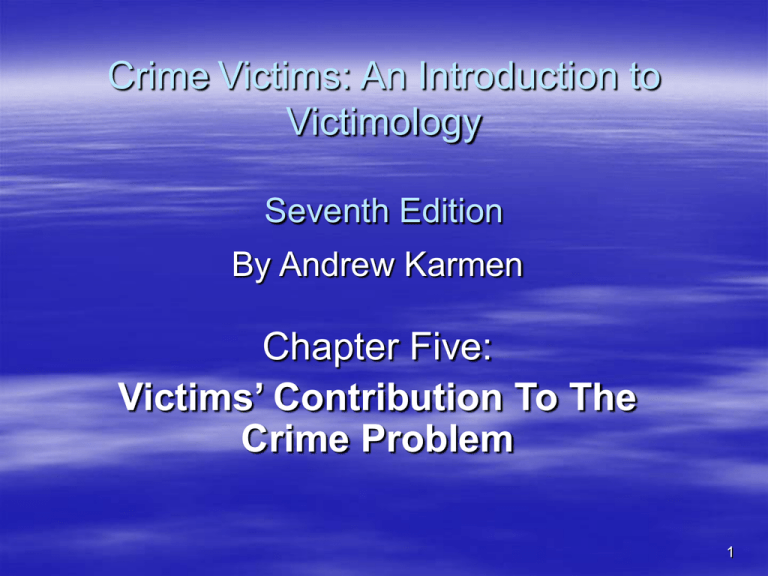
Crime Victims: An Introduction to
Victimology
Seventh Edition
By Andrew Karmen
Chapter Five:
Victims’ Contribution To The
Crime Problem
1
Victim’s Contribution To The
Crime Problem
Theories
– Duet Frame of Reference—Von Hentig, 1941
– Penal Couple—Mendelsohn, 1956
– Doer-Sufferer Relationship—Ellenberger, 1955
Shared Responsibility—Victims as well as
criminals did something wrong
Evidence of Shared Responsibility: See Box 5.1,
Page 110
2
Shared Responsibility Issues
Murder: “…victim is often major contributor…”
(Wolfgang, 1958)
Rape: “…’virtuous’ rape victim is not always the
innocent and passive party.” (Amir, 1971)
Theft: “Victims cause crime in the sense that they
set up the opportunity for the crime to be
committed.” (Jeffrey, 1971)
Burglary: “…understand the extent to which a
victim vicariously contributes to or precipitates a
break-in.” (Waller and Okihiro, 1978)
3
Shared Responsibility
Facilitation—victims unknowingly, carelessly,
negligently and inadvertently make it easier for
offender to commit a theft
– Example: leave a purse visible on a car seat
Precipitation—victim significantly contributes to the
event
– Example: victim was having an affair with killer’s wife
Provocation—worse than precipitation—more
directly responsible for the killing.
– Example: victim started a fight in a bar and ended up
dead
4
Frequency of Shared Responsibility
Study conducted by National Commission on the
Causes and Prevention of Violence
Homicide—person who died was the first to resort
to force—22%
Aggravated Assault—seriously injured first to use
force or offensive action—14%
Armed Robberies—victim did not reasonably
handle money, jewelry or valuables—11%
Forcible Rapes—woman first agreed to sexual
relations or invited through gestures—4%
5
Frequency of Shared Responsibility
for Violent Crimes
Completely innocent victims cannot be blamed for
the crime. They reasonably reduced risks, no
negligence or passive indifference.
They often harden their targets with security devices
and alarms
Victim is totally responsible when there is no
offender—victim may pose as offender—fraud
6
Victim Blaming vs. Victim Defending
Victim Blaming Characterization
– Victims might share responsibility with offender
if facilitation, precipitation, or provocation of the
event occurred
Victim Defending Characterization
– It is not fair to hold the wounded party
accountable for his or her own losses or injuries
7
Victim Blaming vs. Victim Defending
Victim Blaming
– Personal Accountability—Basic doctrine of U.S.
legal system
– “Just World” Outlook—People get what they
deserve
Victim blaming is the view of majority of offenders
8
Victim Blaming vs. Victim Defending
Victim Defending—Rejects the premise that
victims are partly at fault
– Victim blaming criticized for overstating victim’s involvement
– Overstates events of facilitation, precipitation or provocation
– Exhorting people to be more cautious and vigilant is not an
adequate solution
9
Victim Blaming vs. Victim Defending
See Box 5.2, page 120: “Criticisms of the
Notion of Shared Responsibility”
Two tendencies with victim defending
regarding who or what is to be faulted:
– 1. Offender blaming: do not shift any blame
away from offender onto the victim
– 2. System blaming: behaviors of both parties
influenced by society
10
Victim Facilitation and Auto Theft
“Is it the careless who end up carless?”
Trends—Figure 5.2, page 122; Tables 5.1,
page 123, and 5.2, page 124
Most likely victim—under 25, apt. dweller,
urban inner city, African Americans and
Hispanic Americans, low income
11
Victim Facilitation and Auto Theft
Victim blaming focuses on motorists with
bad habits
Victim defending focuses on majority of
motorists who did nothing wrong
– Teenagers are no longer #1 in stealing cars—
organized car rings
12
Typology of Shared Responsibility
Auto Theft:
– Conscientiously Resisting Victims
} 55%
– Conventionally Cautious Victims
– Carelessly Facilitating Victims}
20%
– Precipitative Initiators
– Provocative Conspirators } 25%
– Fabricating Simulators
13
Victim Facilitation and Identity Theft
Identity Theft—Unauthorized appropriation
of personal information
– Names, addresses, date of birth, etc
– Table 5.3, page 129 identifies Identity Theft
Type distribution nationwide in 2006
14
Laws and Law Enforcement
Nearly all states criminalized the unlawful
possession of personal identity information
in the 90s
1998 Congress passed the Identity Theft and
Assumption Deterrence Act
– Provided for financial recovery for victim not just
financial institution
Fair and Accurate Credit Transactions Act of 2003
– Provided for one free credit report per year
15
Laws and Law Enforcement
Problems undermining law enforcement
efforts in fighting Identity Theft
– Many officers lack training and agencies lack
resources to provide adequate response
– Multi-jurisdictional complications undercut an
agency’s commitment to follow through
– Law enforcement agencies stymied as many
instances not reported to police (sometimes not
even the victim is aware of the crime)
16
Victim Facilitation and ID Theft
Risk Reduction Strategies
– Lock up computer, desktop, laptop
– Shred pre-approved credit card invitations
– Discreetly discard receipts and ATM info
– Devise clever passwords
– Never give Social Security number to unknown
person
17
Legal Importance of Determining
Responsibility
Responsibility rests on judgments that are subject
to challenges and criticisms
Whether the victim facilitated, precipitated or
provoked an offender is considered by police,
prosecutors, juries, judges, compensation boards,
insurance examiners, and politicians
It is an issue at many stages of the CJ process,
restitution consideration, civil lawsuits, and
insurance settlements
18
Key Terms
Shared responsibility
Duet frame of reference
Penal couple
Doer-sufferer
relationship
Boost explanation
Flag explanation
Facilitation, Precipitation
provocation
Subculture of violence
Sub intentional death
Justifiable homicide
Typology
Victim blaming, victim
defending
Just world outlook
Offender blaming,
System blaming
Retagging, Chop shops
Conscientiously resisting
victims
Conventionally cautious
victims
Carelessly facilitating
victims
Precipitative initiators,
Provocative Conspiracy
Fabricating simulators
Identity Theft
Dumpster Diving
Phishing,
Pharming
Shoulder Surfing,
Skimming
19


